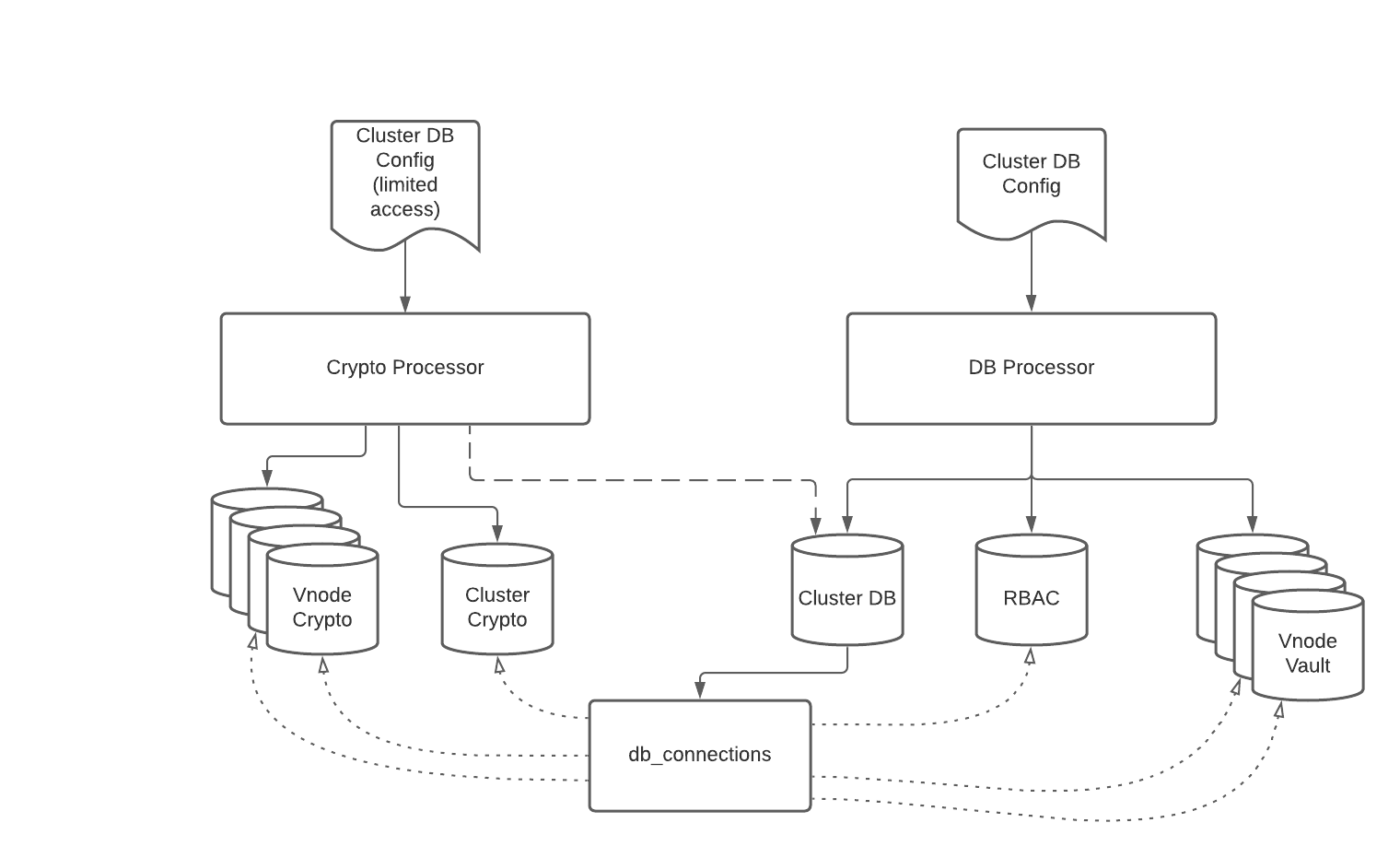-
Notifications
You must be signed in to change notification settings - Fork 27
Corda Databases and the DbConnectionManager
Corda 5 uses several databases, as shown in the diagram below. This section describes how to interact with these databases from within Corda.

Databases in the diagram could be different physical DBs or DB hosts, or they could be logical parts of the "main" DB, separated by schemas, for example. Corda however always treats them as separate DBs that have their own DB configuration.
There are 2 types of databases:
- static — cluster db, rbac db, cluster crypto db. These are a fixed set of DBs created as part of installing the corda cluster and do not change at runtime.
- dynamic — vnode vault and vnode crypto DBs. These are specific to a virtual node hosted on the cluster. New nodes can be added to the cluster at runtime as new VNodes are being onboarded.
The corda cluster DB is the main DB, managing configuration for the cluster itself. Credentials needed to access this DB are always passed in as start-up parameters to the workers & processors (DB Processor and Crypto Processor).
One of the tables in this database is the db_connection table, which contains DB configuration for the other databases in the cluster.
Connections are identified by their name (e.g corda-rbac), and privilege (DDL or DML).
The DbConnectionManager is a singleton component that provides an interface to fetch EntityManagerFactory objects for a given DB.
It must be initialized with the cluster DB configuration so that it can fetch other DB configurations from the cluster DB. This means this component must be bootstrapped early on in the Processor lifecycle and any components that are dependent on a DB connection cannot start until this initialisation is complete.
The DbConnectionManager provides 2 methods to fetch an EntityManagerFactory as well as a method to be able to save a new DB configuration.
EntityManagerFactory for static DBs can be fetched using the following function of the DbConnectionManager:
fun getOrCreateEntityManagerFactory(db: CordaDb, privilege: DbPrivilege): EntityManagerFactoryTo create an EntityManagerFactory you must know the JPA annotated entities that EntityManagers created from this factory will manage. A JpaEntitiesRegistry allows us to specify the classes that are related to a given CordaDb.
This is usually performed in the DB Processor.
For example:
entitiesRegistry.register(CordaDb.RBAC.persistenceUnitName, RbacEntities.classes)EntityManagerFactory for dynamic DBs can fetched using the following function of the DbConnectionManager:
fun getOrCreateEntityManagerFactory(name: String, privilege: DbPrivilege, entitiesSet: JpaEntitiesSet):
EntityManagerFactoryIn this case, you must specify the name as a string (e.g. vnode_vault_<holding-id-hash>) and the database stores this name in the VNode configration table.
This method also needs an JpaEntitiesSet. This could be one fetched from the JpaEntitiesRegistry for schemas that are "well known" (e.g. VNode Crypto DB), or it could be dynamic in case of VNode custom schemas. If the JpaEntitiesSet is dyanmic, the classes need to be in the correct classloader, which may be the DB Sandbox.
In the case of VNodes, you must save new DB connection details at runtime using the following function:
fun putConnection(
name: String,
privilege: DbPrivilege,
config: SmartConfig,
description: String?,
updateActor: String)You can provide the DB connection details either as part of the VNode onboarding, in which case the DB is "managed" outside of Corda, or Corda can create a new "logical" DB inside the cluster DB using an implementation of DbAdmin.
Currently there is only a Postgres implementation, in the future other RMDBs will be added, or other implementations could interface with external managed services for provisioning DBs.